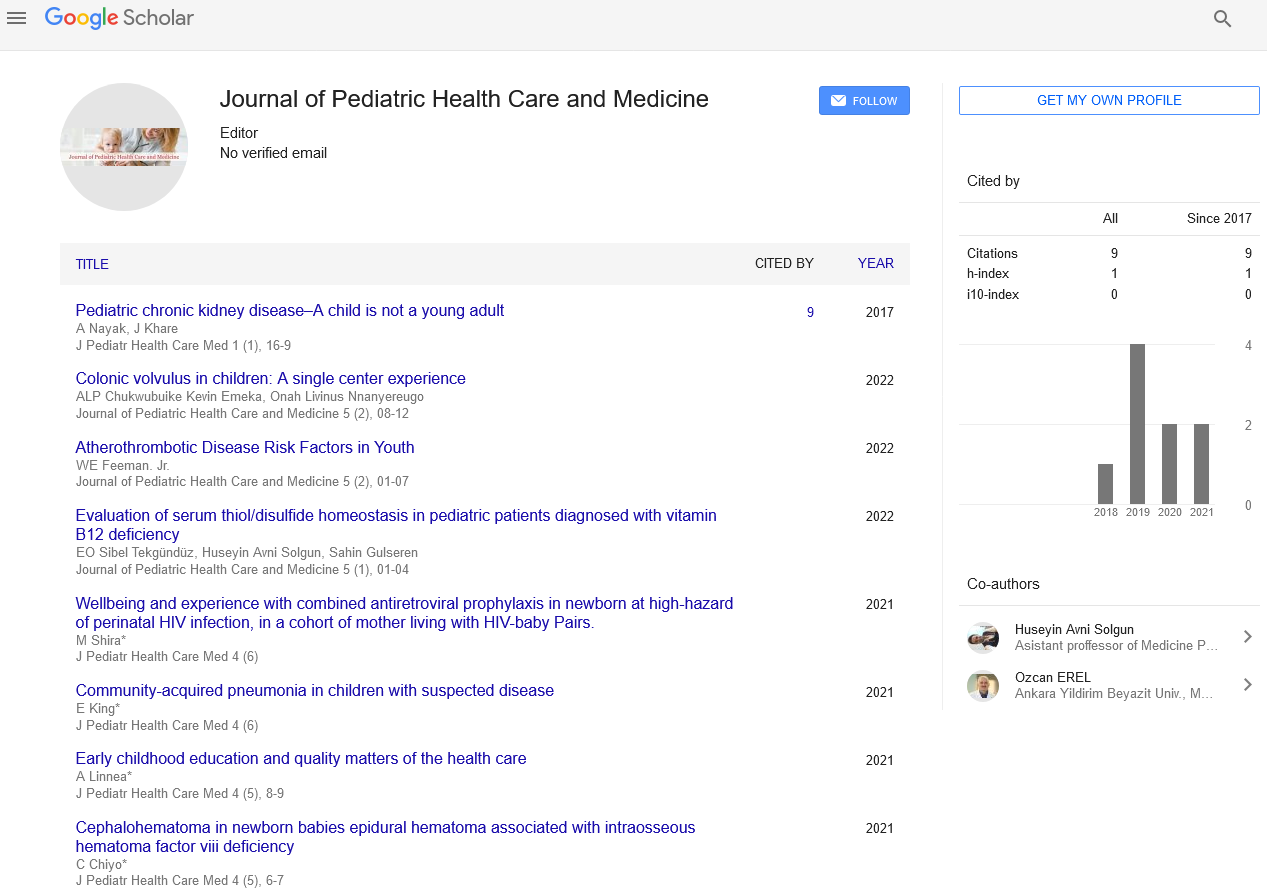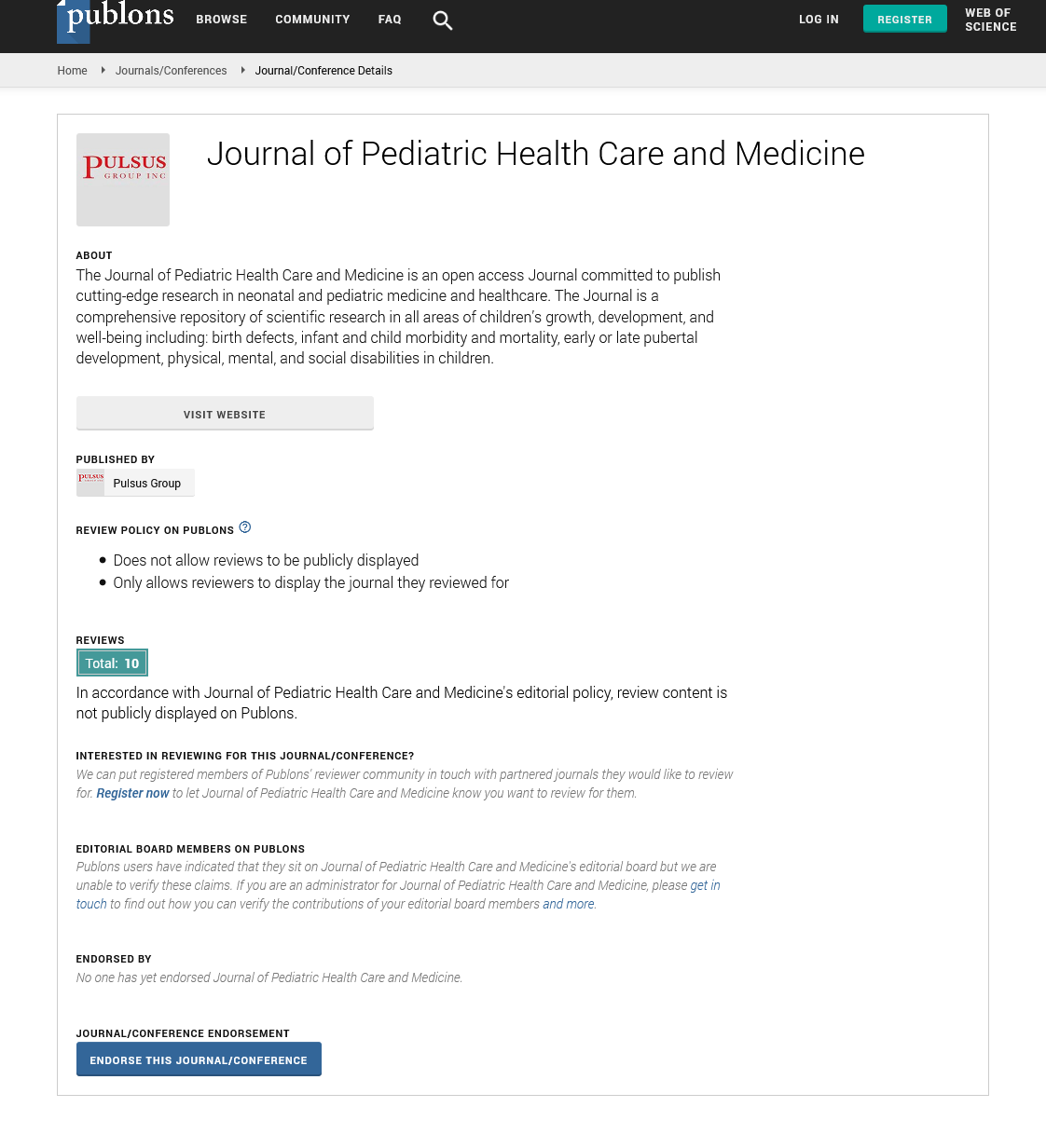Pediatric Healthcare 2020: Neurodevelopment in ventilated newborns weighing less than 1500 grams
2 , Email: nellymendozavazques@edu.com
Received: 30-Dec-2020 Accepted Date: Jan 07, 2021; Published: 20-Jan-2021
Citation: None
This open-access article is distributed under the terms of the Creative Commons Attribution Non-Commercial License (CC BY-NC) (http://creativecommons.org/licenses/by-nc/4.0/), which permits reuse, distribution and reproduction of the article, provided that the original work is properly cited and the reuse is restricted to noncommercial purposes. For commercial reuse, contact reprints@pulsus.com
Abstract
One of the biggest hits of neonatology in recent years has been the progress made in the preterm newborn care, however, prematurity remains the main problem of contemporary neonatology. In premature infants, is of great importance, due to its morbidity, the group of ventilated infants. Ventilation has been a neonatal intensive care technology that has contributed to the decline in infant mortality, especially in very low birth weight infants. However, changes in long-term neurodevelopmental not descend. One possible explanation is that ventilator practices as useful when used in a proportionate and appropriate can damage the developing brain when used excessively (eg. hypocarbia, hyperoxia). So, the question is: what can we do to protect the developing brain?
Abstract
Introduction: One of the biggest hits of neonatology in recent years has been the progress made in the preterm newborn care, however, prematurity remains the main problem of contemporary neonatology. In premature infants, is of great importance, due to its morbidity, the group of ventilated infants. Ventilation has been a neonatal intensive care technology that has contributed to the decline in infant mortality, especially in very low birth weight infants. However, changes in long-term neurodevelopmental not descend. One possible explanation is that ventilator practices as useful when used in a proportionate and appropriate can damage the developing brain when used excessively (eg. hypocarbia, hyperoxia). So, the question is: what can we do to protect the developing brain? Objective: Demonstrate abnormal neurodevelopment in premature infants weighing less than1500 grams that showed changes in levels of CO2 and O2 by ventilation. Methods: Performing a case-control study at the National Institute of Perinatology to assess the association between neurodevelopmental disorders and CO2 and O2 by ventilation. The study was conducted with 249 infants (100%) receiving mechanical ventilation and monitoring neurodevelopmental Pediatric tracking service, with 124 cases (abnormal neurodevelopment) and 125 controls (normal neurodevelopment) which assesses the neurodevelopment at 3 years patients age infants less than 1500 grams who required ventilatory assistance at birth and showed changes in CO2 and O2 related. Results: We analyzed the cases and controls found no statistically significant differences in terms of demographic variables (sex, weight, gestational age, length of stay, days of ventilation and minute Apgar) Table 1. In descriptive statistics found a sex distribution of 134 (53.8%) female and 115 (46.2%) male, mean gestational age of 28.81 weeks and a mean weight of 967.18 grams.
Introduction
Tracking neurodevelopmental assessment was performed with the Terman-Merril, Bayles II, Amieltison, and ultrasound transfontanelar (UST). Diagnosis was altered neurodevelopment according to Terman Merrill test, normality found in 125 (50.2%). According to the result of UST were reported normal 128 (51.4%), with Grade I hemorrhage in 23 (9.2%), Grade II 48 (19.3%) and 50 (20%) with periventricular priventricular. The Bayley Scale of development, the mental scale 76 (30.5%) had less than 69 points scoring with significant delay, 69 (27.7%) were 70 to 84 points qualifying slight delay, 95 (38.2%) with a score between 85 and 114 reported normal development and 9 (3.6%) were rated with a score higher than 115 estimating accelerated development. As for the motor scale 103 (41.4%) had less than 69 points scoring with significant delay, 63 (25.3%) were 70 to 84 points qualifying slight delay, 82 (32.9%) with a score between 85 and 114 reported development normal and 1 (0.4%) were rated with a score higher than 115 estimating accelerated development. Valuing Amiel-Tison reported abnormality in 177 infants (71.1%) and was normal in 72 infants report (28.9%). In motion abnormalities 40 (20%) patients had PCI. To qualify hypocarbia association was identified, hypercarbia, hypoxia and hyperoxia with normal and abnormal neurodevelopment, with statistical significance for hypercarbia (OR 9061, IC 95% 4.895-16.775, p 0.0001), hyperoxia (OR 4820, IC 95% 2.642-8.794, p 0.0001). Following the methodology outlined in Table 2 presents the results of the estimation using bivariate logistic regression, after removal of non-significant variables. First, it is noteworthy that the statistic applied to evaluate the validity of the model as a whole indicates that there are sufficient reasons to accept its validity (omnibus test of the model shows the following results: Chi Square: 146.452, p: 0.0001), we can say the altered levels of oxygen and carbon dioxide explain abnormal neurodevelopment. In addition, Table 3 presents the results anothertests commonly used to assess the goodness of fit of a logistic regression model (called Hosmer and Lemeshow). From the results it is interesting to note the high ability of the model to correctly classify infants studied. Thus, 84.3% of cases globally considered, was well rated. And there are differences between the percentages for normal children and children 86.2 82.5 abnormal.
Conclusion
The neurodevelopmental be assessed routinely in the neonatal intensive care hospital units, with strict criteria for monitoring and assessment programs established. Alterations CO2 y O2 predictpositive and statistically significant association with a populationattributable risk forn eurodevelopmental disorders in bothORand inthe logistic regression. The neurological assessment should be used early for timely intervention. Valuing BayleyII supports reports in the literatura most affected motor scalethanmental. Since its initial useneonatalventilatory supporthas contributed tothe increasedsurvival in the newbornand is currently a priority need for effective strategies gente ventilation characterized by low tidal volumes, permissive hypercarbia and hypoxemia that impact shortlong termcare and the evolution of lung neonatal neurodevelopment. This work is partly presented at 2nd International Conference on Pediatrics, Neonatology and Healthcare on April, 16-17, 2020 at Amsterdam, Netherlands
REFERENCES
- 1. Meadow W, Lee G. Changes in mortality for extremely low birth weight infants in the 1990s: implications for treatment decisions and resource use. Pediatrics 2004; 113:1223- 9.
- 2. Gaillard EA, Cooke RW, Shaw NJ. Improved survival and neurodevelopmental outcome after prolongued ventilation in preterm neonates who have received antenatal esteroids and surfactant. ArchDis Child Fetal and Neonatal Ed 2001; 84: F194- 6.
- 3. Sommenfelt K, Ellertsen B, Markestad T. Personality and behaviour in eight-year-old, nonhandicapped children with birth weight under 1500 g. Acta Paediat 1993; 82:723-728
- 4. Lorenz JM. Management decisions in extremely premature infants. Semin Neonatol 2003; 8:475-82. 90
- 5. Johnson S, Fawke J, Hennessy E, Rowell V. Neurodevelopmental disability through 11 years of age in children born before 26 weeks of gestation. Pediatrics 2009; 124:e249- e57.
- 6. Gray R, Petrou S, Hockley C, Gardner F. Self reported health status and health related quality of life of teenagers who were born before 29 weeks Ìgestational age. Pediatrics 2007; 120: e86-e93.
- 7. Fily A, Pierratn V, Delporte V, Breart G. Factor associated with neurodevelopmental outcome at 2 years after very preterm birth: the Population-Based Nort-Pas-de-Calais EPIPAGE cohort. Pediatrics 2006; 117:357-66.
- 8. Gressens P, Mesples B, Sahir N, Sola A. Environmental Factors and Disturbances of Brain Developmet. Semin. Neonatol. 2001 Apr.; 6(2):185-194.
- 9. Vidal M, CalderoÌn E, Martinez E. Dolor en Neonatos. RevSocEsp Dolor 2005; 12:98 Ì - 111.
- 10. Mondolfi A, Rojas I, Urbina H. Manejo del dolor en Terapia Intensiva y Neonatologia. Ì Rev Archivos Venezolanos de Puericultura y Pediatria 2002; 65:833 Ì -43.
- 11. Carbajal R, Nguyen-Bourgain C, Baptiste J. How can we improve pain relief in neonates? Expert RevNeurother 2008; 8:1617-20.
- 12. Curtis L. Neurodevelopmental Changes of Fetal Pain SeminPerinatol 2007; 31:275-82.
- 13. Ranger M. Johnston C. Current Controversies Regarding Pain Assessment in Neonates. Semin Perinatol 2007; 31: 283-88. 91
- 14. Slater R, Fitzgerald M. Can Cortical Responses Following Noxious Stimulation Inform Us About Pain Processing in Neonates? Semin Perinatol 2007; 31:298-302. 15. Anand K, Phil D. Pain and its Effects in the Human Neonate and Fetus N Engl J Med 1987; 317:1321-29.






